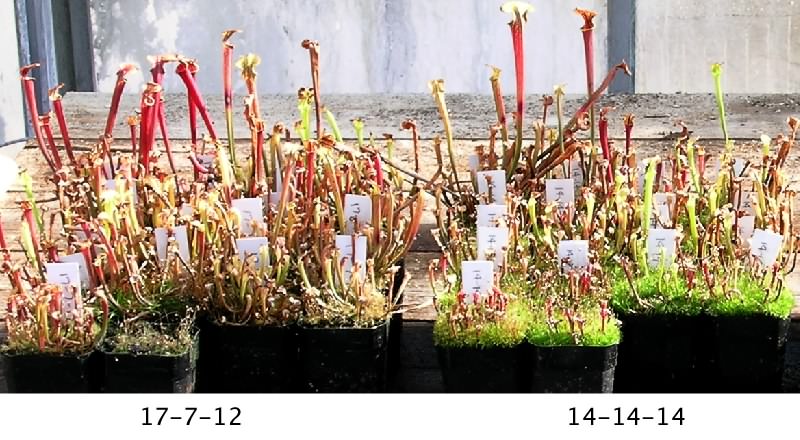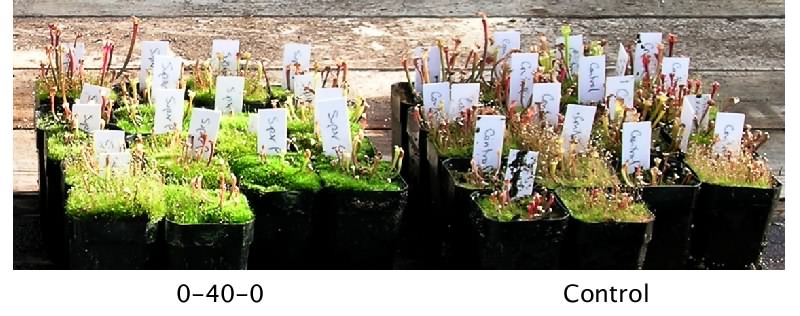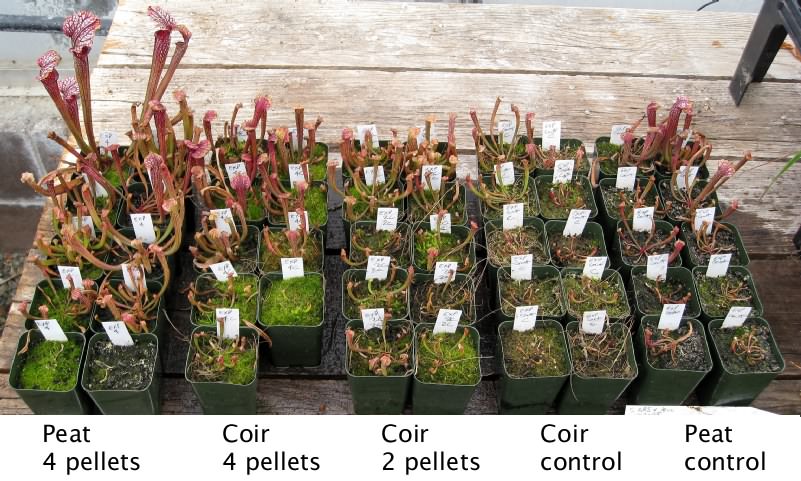You will be living dangerously if you fertilize the soil of your Venus flytraps or sundews but for juvenile Sarracenia it is actually a good idea. Sarracenia are able to absorb nutrients through their roots and and can tolerate enough fertilizer to make a difference. For juvenile plants it makes a huge difference in their growth rate. Soil fertilizing adult Sarracenia is not recommended or at least recommended at the level you can fertilize juvenile plants. For adults it is better to put some dilute fertilizer into the pitchers if the plants are not catching insects.
With soil fertilization of seedling and juvenile Sarracenia, under ideal light, temperature, and nutrient conditions you can get a mature plant in as little as three years. The fertilizer will also encourage moss and other nasty stuff to grow in the soil so you will need to transplant the plants more often. For juvenile plants this isn't usually a problem and may actually stimulate them to grow more.
No amount of fertilizer will make up for lack of light or temperatures too low or too high. Try to grow your plants outside in full sun as much as possible. In some areas a greenhouse has an advantage of moderating temperatures and raising humidity. Growing under lights inside also works but has some drawbacks. Sarracenia are temperate plants and expect seasons. Transitioning from artificial light conditions to natural conditions can be tricky if you want to maintain continuous growth. I have had plants get "confused" and not grow for a year when moved outside.
What fertilizer to use and how much? In my article on Sarracenia soil fertilization (Brittnacher, John (2009) Soil fertilization of Sarracenia seedlings. Carniv. Pl. Newslett. 38(2):36-41 ( PDF )) I gave the results of trying different kinds of fertilizer and different amounts of the kind that worked best.


Fertilizer experiment testing 4 Osmocote™ 9-month 17-7-12, 4 Osmocote™ 4-month 14-14-14, or 4 superphosphate 0-40-0 pellets each pot against a control of no fertilizer. The pellets were placed about 1 cm below the soil surface and the water level was kept at least 2 cm below the surface. Besides the difference between treatments, notice the differences within treatments. Some plants are not going to do well no matter what you do to or for them. All of these plants were grown under ideal conditions in a greenhouse.
The kind of fertilizer that made the most difference was one high in nitrogen. It was also the one that released the fertilizer more slowly. Unfortunately the 9 month release pellets are not readily available. What you can get is Osmocote™ 19-6-12 4-month Outdoor & Indoor Smart Release® Plant Food.
For plants grown outside, fertilizer timing is critical. Ideally you want to fertilize just as new growth starts in the spring. The 4-month release fertilizer is probably preferable for plants grown outdoors since it will release the fertilizer during the peak growth time. The 9-month pellets could continue releasing fertilizer in the fall when the plants need to be thinking about dormancy. For plants grown in a greenhouse the 9 month would be best but putting in new pellets after four months would also work.
I found that 4 pellets per small pot was adequate. Using 6 pellets per small pot did not help and did not hurt. This is good news. When I did the experiment I thought 6 would be too much. It was not too much.
I used Osmocote™ pellets because they release the nutrients slowly for a long time. Alternatively you could water the plants with a dilute fertilizer solution on a regular basis or foliar feed with a higher concentration and then hose off the plants washing the fertilizer into the soil before foliar feeding again. To water regularly a concentration of fertilizer that raises the total dissolved solids 50 ppm should not hurt the plants. That is about 1/2 tsp per 5 gallons. When I foliar feed my carnivores, I use 1/2 tsp of a 20-14-13, urea free water soluble orchid fertilizer per gallon of water in a spray bottle once a month.
The soil you use for your plants also makes a difference. Peat is very acidic and normal plants grown in pure peat or a peat/sand mix have trouble absorbing nutrients or otherwise do not do well. Coir is a neutral medium and should make nutrients more available to the plants. It is used successfully with Nepenthes so I tried it with Sarracenia.

Soil experiment comparing peat and coir, with and without Osmocote™ 17-7-12 pellets. As you can see Sarracenia responded much better to peat soil than coir.
The Sarracenia plants did not like coir as well as peat.
-- John Brittnacher
